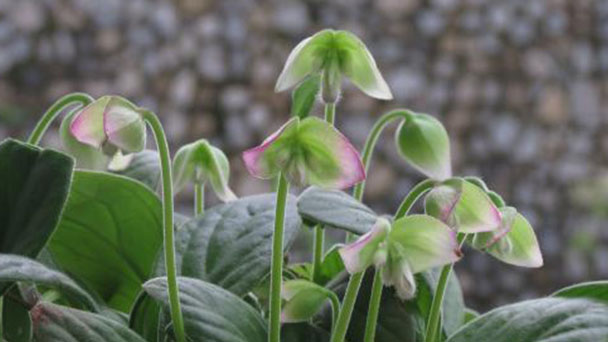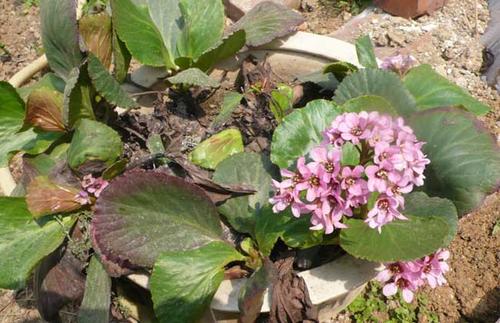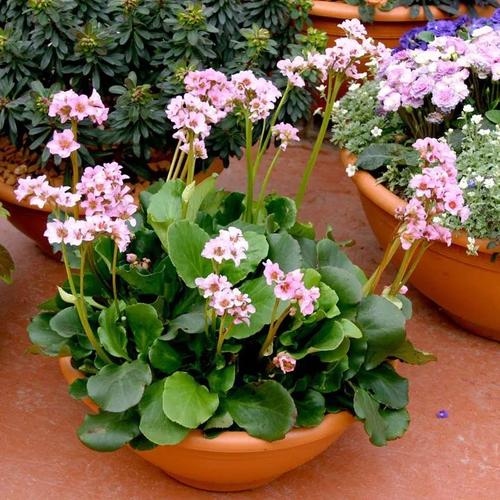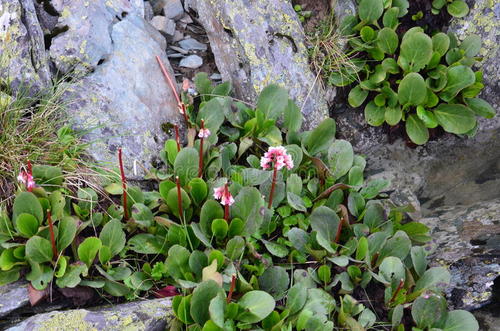Pig Squeak profile
Written by Maggie
Feb 24 2021

Pig Squeak, also called Bergenia, is not a cabbage growing on the edge of a rock. It's an herb. In ancient times, our ancestors used it as a healing herb. Pig Squeak is a good adjunctive treatment for common diseases such as dizziness, weakness, vomiting blood, cough and so on.
Pig Squeak picture

Pig Squeak morphological characteristics
Pig Squeak is a perennial herb, 13-52 cm tall. Rhizome is stout, scaly.
Leaves of pig squeak are homobasal; Leaf blade is leathery, obovate, narrowly ovate to subelliptic, sparsely ovate to sub oblong, 5.5 -- 16 cm long, 3 -- 9 cm wide, apex obtuse, margin undulate to nearly entire, base cuneate, two mask small glandular fossa, glabrous; Petiole of Pig Squeak is 2-7 cm long, stipule margin glabrous. Scape sparsely glandular hairs.
Cymes of Pig Squeak are paniculate, 3-23 cm long; Pedicels are 8 -- 13 mm long, densely petiolate glandular hairs with inflorescence branches; Hypanthium with long stipitate glandular hairs outside; Sepals of Pig Squeak are leathery, sub narrowly ovate, 6.5 -- 7 mm long, 2 -- 4 mm wide, apex obtuse, ventral and margin glabrous, abaxially densely pilose with glandular hairs; Petals are purplish red, broadly ovate, 10 -- 16.5 x 7 -- 7.8 mm, apex obtuse or concave, base narrowly growing claws 2 -- 2.5 mm, multiveined; Stamens of Pig Squeak are 6-11 mm long; Ovary is ovoid, 6.7 -- 7.5 mm long, style 2, 5.3 -- 7.5 mm long
Pig Squeak growth habit
Pig Squeak likes a moist air, warm semi-shade environment and well drained soil. Born in the elevation of 2700-4800 meters under the forest, thickets, alpine meadows and mountain gravel gaps. The soil is brown soil or dark brown forest soil, under shady slope shrub or in rock crevices. The growth is most vigorous on shady slopes and deep humus layers.
Pig Squeak landscape utility
Pig Squeak is easy to grow. The leaves are purplish brown and the flowers are purplish red. The flowers and leaves are very beautiful. Pig Squeak is a common perennial flower for observation of leaves and flowers.
Pig Squeak propagation methods
The emergence rate of Pig Squeak seed seeding was the highest in spring, and the emergence rate was only 22.5%. Seedlings sown in spring grow faster and reach the five-leaf stage, 10-20 days faster than those in summer and autumn, because the vigor of the seeds in spring is stronger. Seeds of Pig Squeak are small, and it is difficult to choose uniformly mature seeds.
Cuttage propagation is the treatment of Pig Squeak rhizoma, cuttage bed planting. Pig Squeak rhizoma cuttings are easy to survive. Cutting in spring, summer and autumn has an average survival rate of 97.2%. The survival rate of cuttings was the highest in summer because of the best temperature and humidity. However, the cutting seedling grows fastest in spring, and the five-leaf period is 10-30 days shorter than summer and autumn. It increased with the increase of shading degree. The best shade for open growth is 85%.

Pig Squeak growing methods
Fertilizer application has a significant effect on the aboveground growth of Pig Squeak. Application of compost and humus soil showed strong growth, mainly in tiller number per Pig Squeak, leaf number per plant and leaf color. The average number of tillers per Pig Squeak was 1.8-2.3 more than that of non-application, and the number of leaves per plant was 2-3 more. The root system of compost and humus soil was more developed, and the root activity was stronger. Perhaps over time, differences will emerge.
Pay attention to the flowers after the timely cut off the residual inflorescence, keep the shape of the plant clean, watering, to prevent sun exposure.
Pig Squeak disease control
Brown spots and aphids are common hazards of Pig Squeak. Brown spot was sprayed with 65% wettable zinc powder and 600 times liquid; Aphids were sprayed with 2.5% Rattan cream 1000 times liquid.
Pig Squeak economic value
Watch
Pig Squeak is easy to grow. It has purplish brown leaves and purplish red flowers. Pig Squeak has beautiful flowers and leaves. It is a common perennial flower for viewing leaves and flowers.
Medicinal
The whole grass contains coumarin such as Pig Squeak (Bergenin). Rhizome as medicine; Pig Squeak is non-toxic; Pig Squeak can treat weakness, dizziness, strain cough, hematemesis, hemoptysis, drenching turbidites, leucorrhea and swelling poison. Exogenous fever and body deficiency with caution.

Latest Updated
- Benefits of Bugleweed - 7 Science-backed Health Benefits
- Bugleweed Dangers & Side Effects - Is It Poisonous?
- How to Plant Evergreen Trees - What You Should Know
- When to Plant Evergreens - Grow Guide for Evergreen Trees
- 12 Wonderful Evergreen Shrubs for Your Garden
- 12 Popular Evergreen Plants with Pictures for Beginners
- When And How To Prune A Lilac Bush Like a Pro
- How to Grow & Care for Lilac Vine (Hardenbergia Violacea)
- Japanese Lilac Tree (Syringa Reticulata) Care & Propagation Guide
- Shumard Oak Pros and Cons - What to Know
Popular Articles
- Winter maintenance of Antirrhinum Majus
- How to Grow Terminalia Mantaly Tree
- How to Grow and Care for Crossostephium Chinense
- How to grow Antirrhinum Majus in spring
- Peristeria Elata (Dove Orchid) Profile: Info & Care Guide
- Underwatered Snake Plant (Sansevieria Trifasciata) - Signs And How To Fix
- How to Care for Brazilian Jasmine Plant (Mandevilla Sanderi)
- How to Grow & Care for Graptopetalum Purple Delight in Summer
- Rosa Chinensis (China Rose): Plant Growing & Care Tips
- How to Care for Baby Sun Rose (Aptenia Cordifolia)